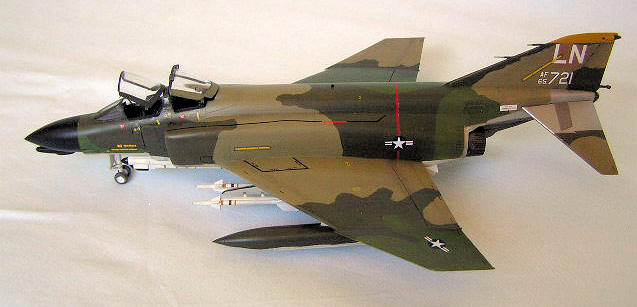
Fujimi 1/72 F-4D Phantom II
| KIT: | Fujimi 1/72 F-4D Phantom II |
| KIT #: | ? |
| PRICE: | approx $22.00 |
| DECALS: | One Option |
| REVIEWER: | Fernando Rolandelli |
| NOTES: |
Pretty acceptable though overshadowed by the newer Hasegawa
offering |

| HISTORY |
The F-4D was an
improved version of the F-4C which was better suited to the specific
requirements of the Tactical Air Command. It was authorized in March of
1964, and the first example flew on
The most
significant change was the replacement of the APQ-100 radar of the F-4C by
the smaller and lighter partly solid-state AN/APQ-109A. This was part of the
AN/APA-165 radar set which introduced an air-to-ground ranging mode using
movable cursors. Some sources claim that F-4Ds fitted with the AN/APQ-109A
radar set could be externally distinguished from the F-4C by
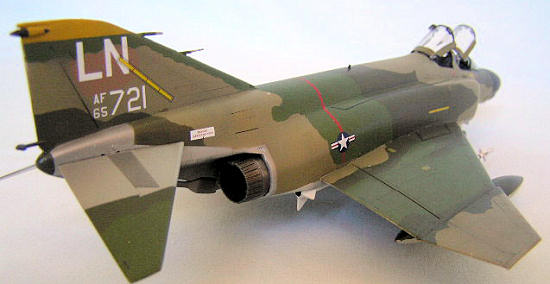 the presence of
a larger radome, but I could not confirm this. The undernose pod for the
AAA-4 infrared search and track was removed. Though reinstalled later, it
did not house the AAA-4 infrared search and track, but rather carried the
forward amplifier and antenna of the ALR-25/26 radar warning system. Later,
this system was replaced by APS-107A with fin antennae and ALR-69(V)2 with
antennae in the chin pod.
the presence of
a larger radome, but I could not confirm this. The undernose pod for the
AAA-4 infrared search and track was removed. Though reinstalled later, it
did not house the AAA-4 infrared search and track, but rather carried the
forward amplifier and antenna of the ALR-25/26 radar warning system. Later,
this system was replaced by APS-107A with fin antennae and ALR-69(V)2 with
antennae in the chin pod.
Externally-hung jammers that could be carried included the ALQ-87 FM barrage
jammer, the Westinghouse ALQ-101 noise/deception jammer, and the
Westinghouse ALQ-119 noise/deception jammer capable of covering three
bands..
An AJB-7
all-altitude bomb delivery system was provided, which was connected to an
ASQ-91 weapons release computer for delivery of laser-guided bombs.
Air-to-air armament included the ill-starred AIM-4D Falcon, which
was quickly replaced by the AIM-9 Sidewinder, AIM-7 Sparrow and an optional
SUU-16 or -23 pod housing a Vulcan 20mm revolving cannon (which could not be
boresighted, thus having a low accuracy). Several TV/laser aiming devices
could be installed, the most widespread being the Westinghouse
AN/ASQ-152(V)-2 Pave Spike laser designator pod and perhaps the most
spectacular the big AN/AVQ-10 Pave Knife, which could be used in nighttime
and was responsible of the bringing down of the Paul Doumer bridge at Hanoi,
on May 10th,
1972, during the Linebecker II offensive.
Only by 1992, the last F-4Ds had been withdrawn from the fighter interceptor groups of the Air National Guard.
| THE KIT |
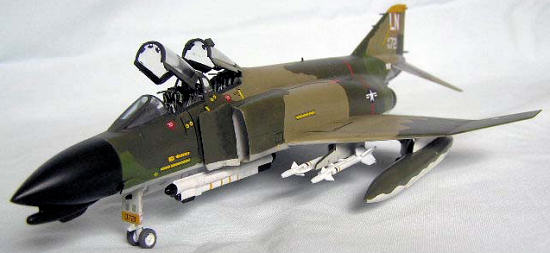
| CONSTRUCTION |
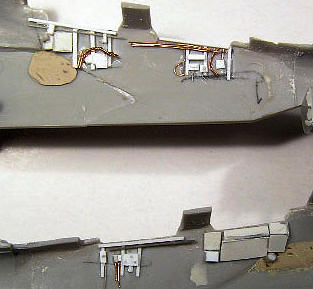
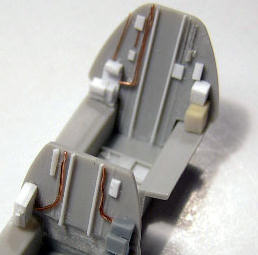 vider between the cockpits to place the rear panel in a suitably high
and correct position. A plethora of cables protrude from its back. To do the
same with the front panel, I resorted to making a mould in plumber’s sealing
rubber of the Hasegawa part and cast it in Parsec resin. It sounds rocket
technology, but it is not, and worked. In the end, the rear bathtub was left
too deep, but it could have been corrected had I realized in time. Other
boxes and things were added following the Aires resin cockpit for the F-4F.
vider between the cockpits to place the rear panel in a suitably high
and correct position. A plethora of cables protrude from its back. To do the
same with the front panel, I resorted to making a mould in plumber’s sealing
rubber of the Hasegawa part and cast it in Parsec resin. It sounds rocket
technology, but it is not, and worked. In the end, the rear bathtub was left
too deep, but it could have been corrected had I realized in time. Other
boxes and things were added following the Aires resin cockpit for the F-4F.
Further detail was added to the wheel bays and U/C
legs. The afterburner cans received interior “petals” made of Tamiya tape.
The rest was really smooth, with a reasonable amount
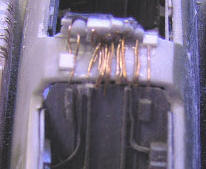 of putty. Most of it
follows the usual breakdown seen in Esci, Revell-Germany and Hasegawa kits
of the Phantom. The single piece fuselage and lower wings make a very strong
structure, as opposed to the rather flimsy two latter named kits
of putty. Most of it
follows the usual breakdown seen in Esci, Revell-Germany and Hasegawa kits
of the Phantom. The single piece fuselage and lower wings make a very strong
structure, as opposed to the rather flimsy two latter named kits .
.
| COLORS & MARKINGS |
 Well, one of the aspects of this project I was
most excited about was painting. This machine sports a modified “SE Asia
Scheme”, with “three greens” instead of “two greens and a tan” (it is
depicted in the cover of an “Air Extra” magazine). Long ago, I had seen, in
a RAF Yearbook, a picture of a F-4D in which “a light green replaced the
usual tan” (oh, those pre-FS years!), a fact that I unsuccessfully put
forward in several live and online discussions. For a while, the doctrine of
the “30219 bad batch” was predominant. Now, it seems that FS34201 (a SAC
color present on FB-111s and B-52s) was field applied to Phantoms based in
the UK (and some others, as picture evidence show), which makes sense, both
in the increased effectiveness of the camouflage as well as in the
availability of the actual paint (that is, if cooperation between TAC and
SAC is as smooth as it should be!). So the scheme rounded up being
34079/34102/34201 over 36622.
Well, one of the aspects of this project I was
most excited about was painting. This machine sports a modified “SE Asia
Scheme”, with “three greens” instead of “two greens and a tan” (it is
depicted in the cover of an “Air Extra” magazine). Long ago, I had seen, in
a RAF Yearbook, a picture of a F-4D in which “a light green replaced the
usual tan” (oh, those pre-FS years!), a fact that I unsuccessfully put
forward in several live and online discussions. For a while, the doctrine of
the “30219 bad batch” was predominant. Now, it seems that FS34201 (a SAC
color present on FB-111s and B-52s) was field applied to Phantoms based in
the UK (and some others, as picture evidence show), which makes sense, both
in the increased effectiveness of the camouflage as well as in the
availability of the actual paint (that is, if cooperation between TAC and
SAC is as smooth as it should be!). So the scheme rounded up being
34079/34102/34201 over 36622.
In my model, all paints came from the Xtracolor range, exception
made of the 34102, which came from the WEMM’s Regia Aeronautica range (where
it poses as Verde Mimetico no. 2!), as the Xtracolor is more of a Medium
Green lacking all Olive content.
 Pictures show a patch of 30219 in the fin,
under the codes (lazy painters!) All were applied with liquid mask over a
traditional Grey primer and preshade, performed both freehand and masked.
Exhaust areas were painted in Alclad Aluminium, Magnesium, whereas the can
themselves in Gunmetal plus a bit of
Jet Exhaust.
Pictures show a patch of 30219 in the fin,
under the codes (lazy painters!) All were applied with liquid mask over a
traditional Grey primer and preshade, performed both freehand and masked.
Exhaust areas were painted in Alclad Aluminium, Magnesium, whereas the can
themselves in Gunmetal plus a bit of
Jet Exhaust.
For decals, I used the stenciling from the kit; Fujimi decals are good enough not to be concerned about them, though the White has a characteristic Japanese ivorish hue. Xtradecals are simply wonderful, easy to use and possessing a painted on look. The Red fuselage band was cut from some solid decal sourced from elsewhere, while the Yellow squadron ID fin top was painted on. I used the usual Set and Sol concoctions on a mostly glossy surface.
| CONCLUSIONS |
I like the final product, though could not help
wondering if all the effort and aftermarkets could have better gone into a
Hase kit, paying the slightly increased price. Well, there are a couple of
interesting F-4Ds remaining in the decal sheet!
| REFERENCES |
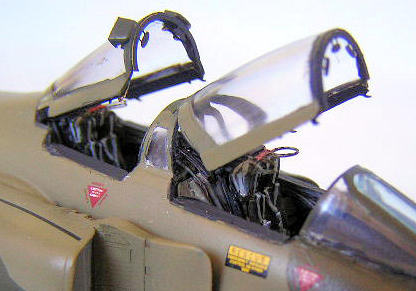 - “Modelling the F-4 Phantom II”, Geoff Coughlin
and Neil Ashby, Osprey Modelling, Osprey Publishing.
- “Modelling the F-4 Phantom II”, Geoff Coughlin
and Neil Ashby, Osprey Modelling, Osprey Publishing.
- J. Baugher website (wonderful historical and
technical stuff)
- “The McDonnell Douglas F-4 Phantom II, A
Comprehensive Guide, Part 1: USAF Variants”, Andy Evans, SAM Limited.
- “Air Extra Magazine no. 15”, Ian Allan
Publications (kindly provided by my friend and countryman Jorge Figari)
July 2008
If you would like your product reviewed fairly and quickly, please contact me or see other details in the Note to Contributors.